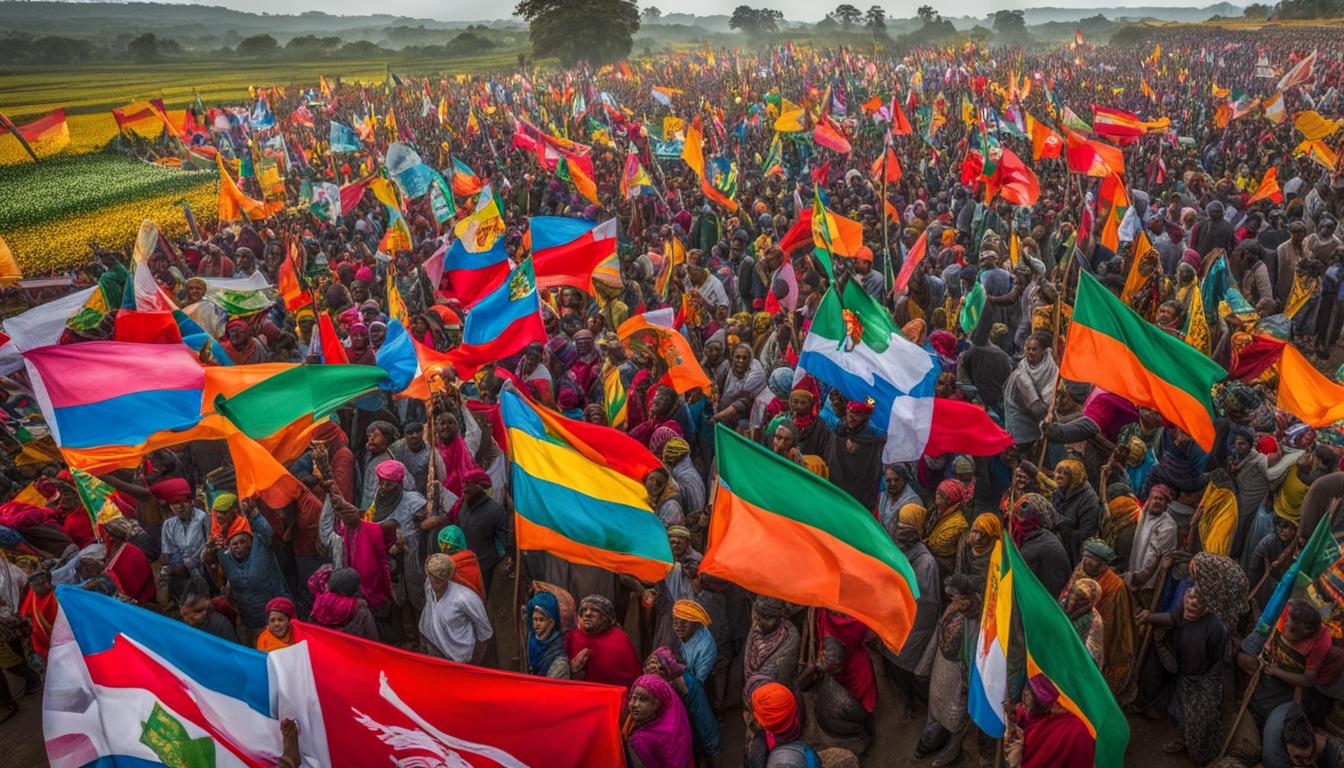The peasant movement in India has become a powerful force fighting for agrarian rights and reforms. In a country where the rural landscape is still predominantly dependent on agriculture, the struggles faced by farmers have sparked widespread protests and demonstrations.
Small-scale farmers make up a significant portion of the rural population in India, with agriculture being their primary source of livelihood. However, the sector’s contribution to the country’s GDP has been declining steadily. Moreover, ecological challenges such as water stress, land degradation, and the excessive use of pesticides and chemical fertilizers have further exacerbated the situation, leading to an uprising demanding change.
The current wave of farmers’ protests has also been triggered by the government’s attempts to liberalize the agricultural sector. Farmers argue that these reforms primarily benefit corporations rather than addressing their needs and concerns.
Key Takeaways:
- The peasant movement in India is a grassroots uprising fighting for agrarian rights and reforms.
- Agriculture remains a primary source of livelihood for the majority of rural households in India.
- The movement has gained momentum due to the struggles faced by small-scale farmers.
- Farmers’ protests have been fueled by ecological calamities and the government’s attempts to liberalize the agricultural sector.
- International figures, such as Rihanna and Greta Thunberg, have shown solidarity with the cause.
Challenges and Demands of the Peasant Movement
The liberalization of agriculture and the introduction of new farm bills by the Indian government have presented significant challenges for the peasant movement in the country. These reforms were intended to bring about much-needed changes to the agricultural sector, including reducing the role of middlemen. However, farmers have expressed concerns that these acts do not actually empower them but rather benefit private capitalists and big corporations.
The main demands of the peasant movement revolve around the restoration of the agricultural Mandis (cooperative markets) and the assurance of a fair Minimum Support Price (MSP) for their crops. They are fighting for the right to guaranteed procurement based on MSP as a legal entitlement, the complete repeal of the new farm laws, and the protection of their rights in the face of further liberalization.
After months of protests and negotiations, the central government has finally recognized the importance of addressing the farmers’ demands. However, it is crucial to understand the significance of these demands within the larger context of the agricultural market and the livelihoods of millions of farmers. The movement has shed light on the deep-rooted issues in the agricultural sector and the need for comprehensive reforms that prioritize the welfare of the farmers.
“The liberalization of agriculture should not come at the expense of our livelihoods and well-being. We need policies that support small-scale farmers and ensure their fair share in the agricultural market.” – Farmer Representative
As the peasant movement continues to gain momentum and achieve success in securing their demands, it emphasizes the vital role farmers play in feeding the nation and the importance of protecting their interests. The movement serves as a powerful reminder that the well-being of farmers should be prioritized in any discussions surrounding agricultural reforms and policies.
Impact of the Peasant Movement
The peasant movement has garnered widespread attention and support, both locally and globally. It has sparked discussions about the future of Indian agriculture, the sustainability of farming practices, and the equitable distribution of benefits.
The movement’s success in pressuring the central government to address the concerns and demands of farmers highlights the power of grassroots mobilization. It has inspired hope for future struggles and initiatives aimed at ensuring the rights and well-being of farmers in India.
This movement has also received significant international support, with influential figures like Rihanna and Greta Thunberg expressing solidarity. This global recognition showcases the scale and importance of the farmers’ movement, transcending national boundaries and advocating for farmer rights and fair agricultural practices worldwide.
| Farmers’ Demands | Government Response |
|---|---|
| Guaranteed procurement based on Minimum Support Price (MSP) as a legal right | Accepted |
| Repeal of new farm laws | Accepted |
| Protection of farmers’ rights in the face of liberalization | Accepted |
The success of the peasant movement in securing their demands is a significant milestone in the ongoing struggle for agrarian rights and reforms in India. It underscores the need for sustainable farming practices, a fair agricultural market, and policymakers’ commitment to addressing farmers’ concerns.
The movement signifies a turning point in Indian agriculture, where the voices of farmers are being heard and heeded. It has revealed the power of collective action and the resilience of those who work tirelessly to feed the nation. The fight for a more equitable and sustainable agricultural sector continues, and the peasant movement has paved the way for a brighter future for Indian farmers.

The Impact and Future of the Peasant Movement
The peasant movement in India has achieved a significant victory with the acceptance of their demands by the central government. This outcome marks an important milestone for farmers’ rights and demonstrates the power of collective action. Throughout their struggle, the movement garnered global solidarity, capturing the attention of influential figures like Rihanna and Greta Thunberg, who voiced their support.
Despite this triumph, the agricultural sector in India continues to grapple with an ongoing crisis. Farmer suicides, mounting debt, and the dominance of corporations persist as pressing issues. The movement has shed light on these challenges, urging the need for drastic changes in the future of Indian agriculture.
Sustainable farming practices are essential for the long-term viability of the sector. They promote eco-friendly methods that reduce the reliance on harmful chemicals, protect natural resources, and ensure the production of safe and nutritious food. Additionally, the movement has sparked discussions about the equitable distribution of benefits within the agricultural industry. It underscores the importance of providing fair compensation for farmers while preventing the exploitation caused by the domination of multinational corporations.
Looking ahead, the future of Indian agriculture remains hopeful. The success of the peasant movement has become a testament to the power of grassroots mobilization, inspiring further advocacy for agrarian rights and reforms. The movement has compelled policymakers and society at large to reconsider the agricultural landscape, highlighting the urgency of sustainable farming practices, diversification of crops, and the creation of a more inclusive and resilient farming system for the benefit of both farmers and the nation.
FAQ
What is the peasant movement in India?
The peasant movement in India is a powerful grassroots uprising fighting for agrarian rights and reforms. It is a response to the challenges faced by farmers in the country, including issues of land rights, food production, and food security.
Why has the peasant movement gained momentum?
The peasant movement has gained momentum due to the struggles faced by small-scale farmers, who make up a significant portion of the rural population in India. Agriculture remains a primary source of livelihood for 70 percent of rural households, yet its contribution to GDP has been declining. Additionally, ecological calamities such as water stress, land degradation, and the overuse of pesticides and chemical fertilizers have fueled the movement.
What is the main challenge faced by the peasant movement in India?
The main challenge faced by the peasant movement in India is the government’s desire to open up the agricultural market through liberalization. The introduction of three farm bills aimed to reform the agriculture sector and reduce the role of middlemen. However, farmers argue that these acts benefit private capitalists rather than the farmers themselves.
What are the demands of the farmers in the peasant movement?
The farmers’ demands include guaranteed procurement based on Minimum Support Price (MSP) as a legal right, repeal of the new farm laws, and the protection of their rights in the face of agricultural liberalization.
Has the central government accepted the demands of the peasant movement?
After months of protests and negotiations, the central government has finally accepted the major demands of the farmers, including the restoration of the primacy of agricultural Mandis (cooperative markets) and the assurance of Minimum Support Price (MSP) for agricultural produce.
What impact has the peasant movement in India made?
The peasant movement in India has achieved a significant victory with the acceptance of their demands by the central government. The movement has received support not only from the Indian diaspora but also from international figures such as Rihanna and Greta Thunberg, highlighting the global solidarity behind the cause.
What are the ongoing challenges in the agricultural sector in India?
Despite the success of the peasant movement, the agricultural sector in India is still facing an ongoing crisis, with high instances of farmer suicides, debt, and the dominance of corporations.
What questions does the peasant movement raise about the future of Indian agriculture?
The peasant movement has raised important questions about the future of Indian agriculture, including the need for sustainable farming practices, equitable distribution of benefits, and the diversification of crops.
What does the success of the peasant movement signify?
The success of the peasant movement has shown the power of grassroots mobilization and has inspired hope for future struggles in the fight for agrarian rights and reforms in India.
